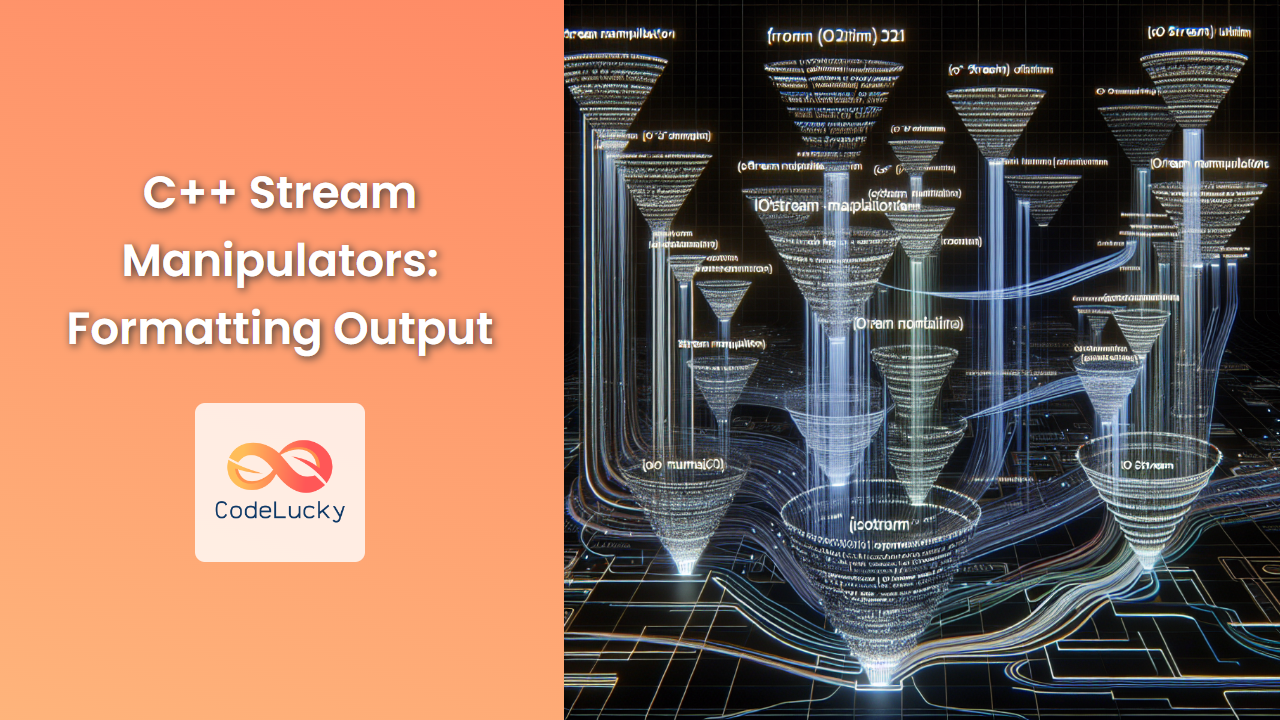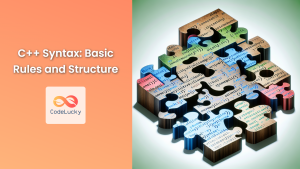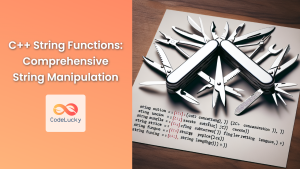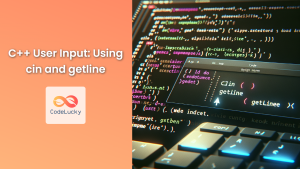In the world of C++ programming, presenting data in a clean, organized, and readable format is crucial. This is where stream manipulators come into play. These powerful tools allow you to control the way output is formatted, making your data more presentable and easier to understand. In this comprehensive guide, we'll dive deep into C++ stream manipulators and explore how they can enhance your output formatting skills.
Understanding Stream Manipulators
Stream manipulators are special functions or objects that can be inserted into input or output streams to modify their behavior. They're particularly useful for formatting output, controlling precision, setting field widths, and much more.
Let's start with a simple example to illustrate the concept:
#include <iostream>
#include <iomanip>
int main() {
std::cout << std::setw(10) << "Hello" << std::setw(10) << "World" << std::endl;
return 0;
}
Output:
Hello World
In this example, std::setw(10) is a stream manipulator that sets the width of the next output field to 10 characters.
🔍 Note: The <iomanip> header is required for most formatting manipulators.
Common Stream Manipulators
Let's explore some of the most frequently used stream manipulators in C++:
1. setw() – Set Field Width
The setw() manipulator sets the width of the next field to be output.
#include <iostream>
#include <iomanip>
int main() {
int num = 42;
std::cout << std::setw(10) << num << std::endl;
std::cout << std::setw(10) << "C++" << std::endl;
return 0;
}
Output:
42
C++
🚀 Pro Tip: setw() only affects the next field in the output stream. You need to use it before each field you want to format.
2. setfill() – Set Fill Character
setfill() specifies the character used to pad the output when the field width is larger than necessary.
#include <iostream>
#include <iomanip>
int main() {
std::cout << std::setw(10) << std::setfill('*') << 42 << std::endl;
std::cout << std::setw(10) << std::setfill('-') << "C++" << std::endl;
return 0;
}
Output:
********42
-------C++
3. left, right, and internal – Alignment
These manipulators control the alignment of output within a field.
#include <iostream>
#include <iomanip>
int main() {
int num = -42;
std::cout << std::setw(10) << std::left << num << std::endl;
std::cout << std::setw(10) << std::right << num << std::endl;
std::cout << std::setw(10) << std::internal << num << std::endl;
return 0;
}
Output:
-42
-42
- 42
💡 Insight: internal aligns the sign to the left and the value to the right within the field.
4. setprecision() – Set Floating-Point Precision
setprecision() sets the number of digits to display after the decimal point for floating-point numbers.
#include <iostream>
#include <iomanip>
int main() {
double pi = 3.14159265358979323846;
std::cout << std::setprecision(3) << pi << std::endl;
std::cout << std::setprecision(10) << pi << std::endl;
return 0;
}
Output:
3.14
3.141592654
5. fixed and scientific – Floating-Point Notation
These manipulators control how floating-point numbers are displayed.
#include <iostream>
#include <iomanip>
int main() {
double num = 123456.789;
std::cout << std::fixed << std::setprecision(2) << num << std::endl;
std::cout << std::scientific << num << std::endl;
return 0;
}
Output:
123456.79
1.23e+05
🔬 Deep Dive: fixed forces decimal notation, while scientific uses scientific notation.
6. showpoint and noshowpoint – Display Decimal Point
These manipulators control whether the decimal point is always shown for floating-point numbers.
#include <iostream>
#include <iomanip>
int main() {
double num = 100.0;
std::cout << std::showpoint << num << std::endl;
std::cout << std::noshowpoint << num << std::endl;
return 0;
}
Output:
100.000
100
7. boolalpha and noboolalpha – Boolean Representation
These manipulators control how boolean values are displayed.
#include <iostream>
int main() {
bool t = true, f = false;
std::cout << t << " " << f << std::endl;
std::cout << std::boolalpha << t << " " << f << std::endl;
std::cout << std::noboolalpha << t << " " << f << std::endl;
return 0;
}
Output:
1 0
true false
1 0
Advanced Stream Manipulator Techniques
Now that we've covered the basics, let's explore some more advanced techniques and combinations of stream manipulators.
Combining Multiple Manipulators
You can use multiple manipulators together to achieve more complex formatting:
#include <iostream>
#include <iomanip>
int main() {
double price = 1234.56789;
std::cout << std::fixed << std::setprecision(2) << std::setw(10)
<< std::right << std::setfill('*') << price << std::endl;
return 0;
}
Output:
***1234.57
In this example, we've combined fixed, setprecision, setw, right, and setfill to create a nicely formatted price display.
Creating Custom Manipulators
You can create your own manipulators to encapsulate complex formatting logic:
#include <iostream>
#include <iomanip>
std::ostream& currency(std::ostream& os) {
os << std::fixed << std::setprecision(2) << std::showpoint;
return os;
}
int main() {
double price = 42.0;
std::cout << currency << "$" << price << std::endl;
return 0;
}
Output:
$42.00
🎨 Creative Tip: Custom manipulators can greatly simplify your code when you have consistent formatting needs throughout your program.
Using Manipulators with User-Defined Types
Stream manipulators can also be used with user-defined types by overloading the << operator:
#include <iostream>
#include <iomanip>
class Person {
public:
Person(std::string name, int age) : name(name), age(age) {}
friend std::ostream& operator<<(std::ostream& os, const Person& p);
private:
std::string name;
int age;
};
std::ostream& operator<<(std::ostream& os, const Person& p) {
os << std::left << std::setw(15) << p.name << std::right << std::setw(3) << p.age;
return os;
}
int main() {
Person alice("Alice", 30);
Person bob("Bob", 25);
std::cout << alice << std::endl;
std::cout << bob << std::endl;
return 0;
}
Output:
Alice 30
Bob 25
Practical Applications
Let's look at some real-world scenarios where stream manipulators can be incredibly useful:
Formatting Financial Reports
Stream manipulators are perfect for creating neatly aligned financial reports:
#include <iostream>
#include <iomanip>
#include <vector>
#include <string>
struct FinancialEntry {
std::string item;
double amount;
};
void printFinancialReport(const std::vector<FinancialEntry>& entries) {
std::cout << std::left << std::setw(20) << "Item"
<< std::right << std::setw(10) << "Amount" << std::endl;
std::cout << std::setfill('-') << std::setw(30) << "" << std::endl;
std::cout << std::setfill(' ');
double total = 0.0;
for (const auto& entry : entries) {
std::cout << std::left << std::setw(20) << entry.item
<< std::right << std::setw(10) << std::fixed << std::setprecision(2)
<< entry.amount << std::endl;
total += entry.amount;
}
std::cout << std::setfill('-') << std::setw(30) << "" << std::endl;
std::cout << std::setfill(' ');
std::cout << std::left << std::setw(20) << "Total"
<< std::right << std::setw(10) << std::fixed << std::setprecision(2)
<< total << std::endl;
}
int main() {
std::vector<FinancialEntry> report = {
{"Revenue", 10000.50},
{"Expenses", -4500.75},
{"Taxes", -1500.00}
};
printFinancialReport(report);
return 0;
}
Output:
Item Amount
------------------------------
Revenue 10000.50
Expenses -4500.75
Taxes -1500.00
------------------------------
Total 3999.75
Creating Tabular Data
Stream manipulators can help create well-formatted tables:
#include <iostream>
#include <iomanip>
#include <vector>
#include <string>
struct Student {
std::string name;
int age;
double gpa;
};
void printStudentTable(const std::vector<Student>& students) {
std::cout << std::left << std::setw(15) << "Name"
<< std::right << std::setw(5) << "Age"
<< std::setw(8) << "GPA" << std::endl;
std::cout << std::setfill('-') << std::setw(28) << "" << std::endl;
std::cout << std::setfill(' ');
for (const auto& student : students) {
std::cout << std::left << std::setw(15) << student.name
<< std::right << std::setw(5) << student.age
<< std::setw(8) << std::fixed << std::setprecision(2) << student.gpa << std::endl;
}
}
int main() {
std::vector<Student> students = {
{"Alice", 20, 3.75},
{"Bob", 22, 3.52},
{"Charlie", 21, 3.88}
};
printStudentTable(students);
return 0;
}
Output:
Name Age GPA
----------------------------
Alice 20 3.75
Bob 22 3.52
Charlie 21 3.88
Best Practices and Tips
To make the most of C++ stream manipulators, keep these best practices in mind:
-
🔄 Reset manipulators: Some manipulators (like
setw) only affect the next output operation. Reset or reapply them as needed. -
🧩 Combine manipulators: Use multiple manipulators together to achieve complex formatting.
-
📏 Consistent formatting: For repeated formatting tasks, consider creating custom manipulators or functions.
-
🏷️ Use meaningful names: When creating custom manipulators, use descriptive names that indicate their purpose.
-
🔍 Be aware of precision: When working with floating-point numbers, be mindful of the precision you set to avoid unintended rounding.
-
🧪 Test thoroughly: Different data can produce unexpected results. Test your formatting with various inputs.
-
📚 Document your choices: If you're using complex formatting in a larger project, document your formatting decisions for other developers.
Conclusion
C++ stream manipulators are powerful tools for formatting output. They allow you to create clean, organized, and professional-looking output with ease. From simple tasks like setting field widths to more complex operations like creating custom manipulators for specific formatting needs, these tools offer a wide range of possibilities.
By mastering stream manipulators, you can significantly improve the readability and presentation of your program's output. Whether you're creating financial reports, displaying scientific data, or just trying to make your console output more user-friendly, stream manipulators are an essential skill in any C++ programmer's toolkit.
Remember, good formatting isn't just about aesthetics—it's about clear communication of information. With the techniques and examples provided in this guide, you're now well-equipped to format your C++ output like a pro. Happy coding!
- Understanding Stream Manipulators
- Common Stream Manipulators
- 1. setw() – Set Field Width
- 2. setfill() – Set Fill Character
- 3. left, right, and internal – Alignment
- 4. setprecision() – Set Floating-Point Precision
- 5. fixed and scientific – Floating-Point Notation
- 6. showpoint and noshowpoint – Display Decimal Point
- 7. boolalpha and noboolalpha – Boolean Representation
- Advanced Stream Manipulator Techniques
- Practical Applications
- Best Practices and Tips
- Conclusion
















